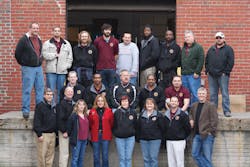Scott Halloran and Michael Calkins give new meaning to the term 'friendly competitors.' In 2011, after successfully running their own vending operations for years, they merged their companies and became an 11-route operation with 40 micro markets, serving the greater Richmond, Va. area.
"We were two like-minded local companies using technology," said Halloran. To him and Calkins, it made more sense to become partners instead of remain competitors.
Merging allowed Trolley House to take advantage of route driver efficiencies and additional locations. It also helped the operation survive the Great Recession. "It [the recession] drove two or three other vending operators out of business in our area," said Calkins. Trolley House, however, emerged strong and prosperous.
Better hours in vending
Halloran began his vending company, Fresh Direct, in 1995 as a way to make money while he was in college. He had four drink machines in Richmond and serviced them on weekends. After college he worked in the restaurant industry briefly before getting married and realizing vending offered him better work hours. That's when he dedicated himself to growing Fresh Direct full-time.
Sometimes Halloran can't believe how different business was then. "When I started in 1995, there were just…12-ounce cans, small chips, candy, cookies and pastries…no website, no marketing plan, no cell phones…we were working off pagers and an answering service," he remembered. As Fresh Direct grew, Halloran adapted to these new technologies, including the need for vending management software, which he added in 2006.
After a number of acquisitions, he also decided to rebrand the company to better incorporate new and old routes. In 2009, he changed the name to Halloran Refreshment Services.
Always with an eye to the future, Halloran knew he wanted to grow and was looking at new product delivery methods in the industry, which sparked the next chapter in his vending operation - a merger and micro markets.
Employee turned owner
Calkins started with Vending Services of Richmond in 2006 after a career in sales and business management. He was attracted to the business after closely watching his brother-in-law build it over 28 years. “The company always managed to do well and seemed like an excellent opportunity to own a business,” said Calkins. "There are not many businesses you can own that bring a smile to someone's face," he added.
In 2008, when his brother-in-law wanted to sell, Calkins found an interested partner, and bought the company. Almost immediately, he started making changes that would help the operation expand. The biggest change was to add vending management software to the entire operation. "It [vending management software] helps to give you control of the business," said Calkins.
Wanting control of the business, and using technology to get it, was one of the things Calkins and Halloran had in common. They met in 2010 to discuss the latest exciting trend in vending -- micro markets. As they talked it became obvious Halloran and Calkins valued the same business principles and were headed in a similar directions. "We both had Streamware, did OCS, vending and were going to jump into micro markets," said Halloran. "It seemed to make sense to become partners instead of remain competitors."
On July 1, 2011, Halloran Refreshment Services and Vending Services of Richmond merged to become Trolley House Refreshments. Halloran and Calkins appointed themselves managing directors and Calkins' old partner went back into corporate America.
Micro markets take off for Trolley
Before the merger, both Halloran and Calkins wanted to explore micro markets. They had each installed four Avanti Markets in a year. They were such a success, in less than two years Trolley House had added 32 additional micro markets.
"Micro markets allowed us to expand our products," said Calkins. Trolley House could offer customers 400 products in the markets. And many of the healthier items also did well in vending, if the price point wasn't too high. The partners found products like string cheese, rice chips and protein bars crossed over well.
Markets bring increase food sales
Food items sold well in micro markets. For Trolley House, food represents 30 percent of micro market sales, while only 2 to 3 percent in vending.
"The huge increase in fresh food usage challenged us internally at first," said Halloran. Trolley House had to add large walk-in coolers, create refrigerated zones in the trucks and add systems and security to track food temperate. It does not operate its own commissary, instead buying food from a third-party.
Every month, Trolley House continues to add micro markets. Ideal locations include 150 or more people who work for one company within a semi-secure area. Public locations don't work well and increase shrinkage.
Promote new markets
Promoting a new micro market is important to success. "We always hold a grand opening the first day," said Calkins.
Trolley House sets the stage with balloons, flyers, raffle prizes and edible samples. The grand opening allows Trolley House to teach location employees how to use the micro market kiosk and put money on their Avanti card. About 50 percent of employees use the market cards to pay instead of cash or credit.
While Trolley House recognizes that micro markets have a place in the successful vending business model, vending is still a strong opportunity. "Vending is never going away, so we're investing big in vending too," said Halloran.
Vending management and prekitting
It wasn't just micro market technology that helped Trolley House grow, but also vending management software and prekitting. Both Halloran and Calkins added Streamware VendMax software to their operations. It helped the two owners develop route efficiencies and save on labor. Halloran calculates the return on investment, with just those benefits, was 24 months. For this there are also other efficiencies that are harder to measure, such as the benefits and savings related to prekitting.
Halloran started prekitting in 2009, while Calkins didn't start until the two operations merged into Trolley House. Prekitting had many benefits, including allowing Trolley House to customize products by location. A location could make special requests and have unique products, rather than what was available on the route driver's rolling warehouse. "It becomes the customer's machine," said Calkins.
A year after the merger, Trolley House took its prekitting program to the next level by installing LightSpeed Automation, a pick-to-light system for the vending warehouse.
"It was one of the easiest technology roll outs I've ever experienced," said Halloran about LightSpeed.
Not only has LightSpeed allowed Trolley House to prekit products more quickly, but it created a centralized point where all the data is funneled. The Avanti and Streamware data both funnel into the LightSpeed system.
"We even created a committee where the warehouse manager meets monthly with the vending manager and micro market manager to discuss issues," said Halloran. Issues might include bad data, shrinkage or slow selling products. The managers analyze the bottom selling units for vending and micro markets on a month to month basis and change out the slowest moving products to provide better variety to the customer. "We're finally catching up to retail," said Halloran, "we're going to do a much better job moving forward."
Halloran and Calkins have found their employees very helpful throughout the technology rollouts. "We've got a really good team," Halloran said. Trolley House has almost zero turnover with most drivers working 5 to 20 years. It offers drivers full benefits and competitive salaries.
Adding the cashless component
While Trolley House has always been an early adopter of technology it didn't add many cashless payment options to its machines. "I was never excited about cashless platforms," said Halloran, "until VendScreen."
Halloran likes that VendScreen is built on an upgradable Android platform, it's interactive unlike traditional electronic payment options, and it links back into Trolley House's back-ending management software. It will even allow Trolley House to display calorie and nutrition information necessary to meet the pending calorie disclosure rules. "Finally, there was a value added. I'd be a fool not to do this," concluded Halloran.
Trolley House is the story of unlikely partners. Both Halloran and Calkins are vending industry veterans and forward thinkers who were able to set aside being competitors and become co-owners. By embracing new technologies from management software to micro markets to new payment platforms, they've reaped the benefits with higher profits and tremendous growth.








